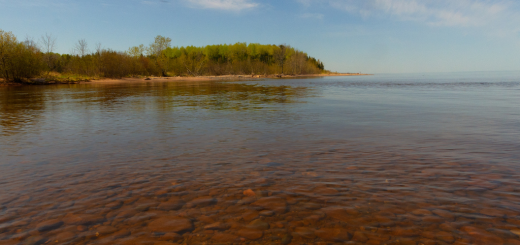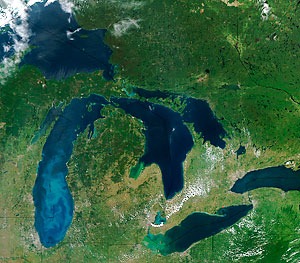Though lake research is relatively new as far as branches of science are concerned, Indigenous Peoples across the world have spent millions of years invested in studying, understanding and protecting lake resources. More modernly, Indigenous Tribes and researchers have continued to dedicate time and resources to assess lakes that hold significance to many First Nations. This significance extends beyond the use of a technical resource—for example, in the Laurentian Great Lakes, both the terrestrial and aquatic ecological systems hold spiritual, cultural and subsistence significance to various groups. As such, Native American Tribes local to the region have historically been dedicated to monitoring the impacts of natural and anthropogenic pressures as they shape the Great Lakes.

Industrial sunrise over Lake Huron (Credit: Christian Collins via Flickr CC BY-SA 2.0)
Recognizing the long-standing relationship between Native American Tribes and lake environments, a 2022 Great Lakes Observing System protocol seeks to create a systematic approach to integrating Indigenous Peoples-related environmental research within the basin of the Laurentian Great Lakes into research considerations.
Methods
In considering which peer-reviewed articles to include in the data, reviewers stated that the protocol would discriminate based on the following:
- Primary Research Question: Main topics must align with other subjects covered by environmental research involving Indigenous communities and organizations around the Great Lakes basin.
- Population: Included studies focus on Indigenous Peoples and Nations surrounding the Great Lakes basin.
- Study Intent: Peer-reviewed articles that pertain to environmental research.
- Geographical Scope: Articles focus on the Great Lakes region, using Treaty maps and watershed boundaries to determine connected tributaries.

Sunset over southern Lake Huron (Credit: RDRandolph via Flickr CC BY-SA 2.0)
In order to systematically meet the aforementioned requirements for studies, reviewers used keywords and relevant combinations using Boolean operators. After sifting through thousands of relevant articles, the studies are screened by two reviewers to ensure they meet all of the relevant variables. This evaluation was categorized under two stages: title and abstract screening and full-text analysis. Two researchers review the article to ensure they meet the requirements with some (5%) overlap to confirm accuracy. If the reviewers cannot reach a consensus on inclusion, a third reviewer will come in to decide whether a study is to be included or excluded.
Conclusion
After compiling the data, researchers hoping to use the protocol can use the collected studies to identify research trends and interests. Additionally, reviewers can spot gaps in research and knowledge to craft future studies in the Great Lakes region.
This protocol has the potential to be used across fields of science to highlight under-researched topics/research gaps. The researchers involved propose mapping these studies geospatially to illustrate areas within the Great Lakes that have been the focus of environment-related research by Indigenous groups to further emphasize the topics and potential influence of these studies.
Source
- Serville-Tertullien, M., Pirie, E., Buell, M.-C., Wall, B. M., & Furgal, C. (2023). Indigenous Peoples-related environmental research within the basin of the Laurentian Great Lakes: A systematic map protocol. Ecological Solutions and Evidence, 4, e12199. https://doi.org/10.1002/2688-8319.12199







